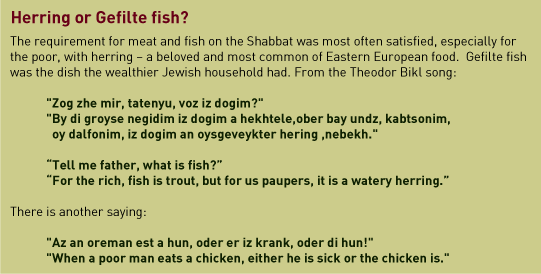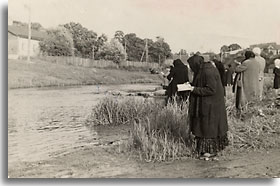




Holidays and Holiday Meals
The cultural and religious organization of the Jewish year is marked by celebration and commemoration of many holidays, some religious and some historical. Traditional Jews observe this calendar, combining their formal communal prayers in the synagogue, with gatherings at home for special meals. Some holidays, like Passover (Peysekh, in Yiddish) and Succoth center more distinctly on meals, while others, like Rosh Hashanah and Yom Kippur, rely more on the communal synagogue prayers. But each holiday has special foods associated with it.
Learn about the holidays listed below and the foods that accompany them:
Rosh Hashanah  , the New Year on the Jewish calendar, is celebrated for two days in September or early October. The traditional foods of this holiday are symbolic of the qualities that are hoped for the oncoming year: sweetness, roundness, and fullness.
, the New Year on the Jewish calendar, is celebrated for two days in September or early October. The traditional foods of this holiday are symbolic of the qualities that are hoped for the oncoming year: sweetness, roundness, and fullness.
The Round Challah
The Rosh Hashanah challah is often round like a circle, with no beginning or end, much like the calendar year that has just ended and the new one that has just begun. It can also be braided like a ladder, to remind us that we should aspire to ascend to greater heights in the new year. This challah is usually baked with raisins, providing extra sweetness for a sweet new year. On the table there also will be honey, in which apples and the bread are dipped.


Tsimmes
One Rosh Hashanah dish particularly popular among Eastern European Jews is tsimmes, a sweet carrot stew. In addition to sweetness, the carrots here also symbolize reproduction, as mern, the Yiddish word for carrots, also shares that meaning. A typical recipe for tsimmes calls for the carrot to be sliced and cooked with honey or jam.
Fruits
The pomegranate, another Rosh Hashanah food symbol in addition to the apple. Its many seeds represent fertility, on the one hand, and, on the other, the 613 commandments of the Torah. Would you want to count the seeds to corroborate this?
Fish
In Eastern European Jewish tradition, fish are often cooked and served with the head intact, to symbolize the beginning of the coming year.














